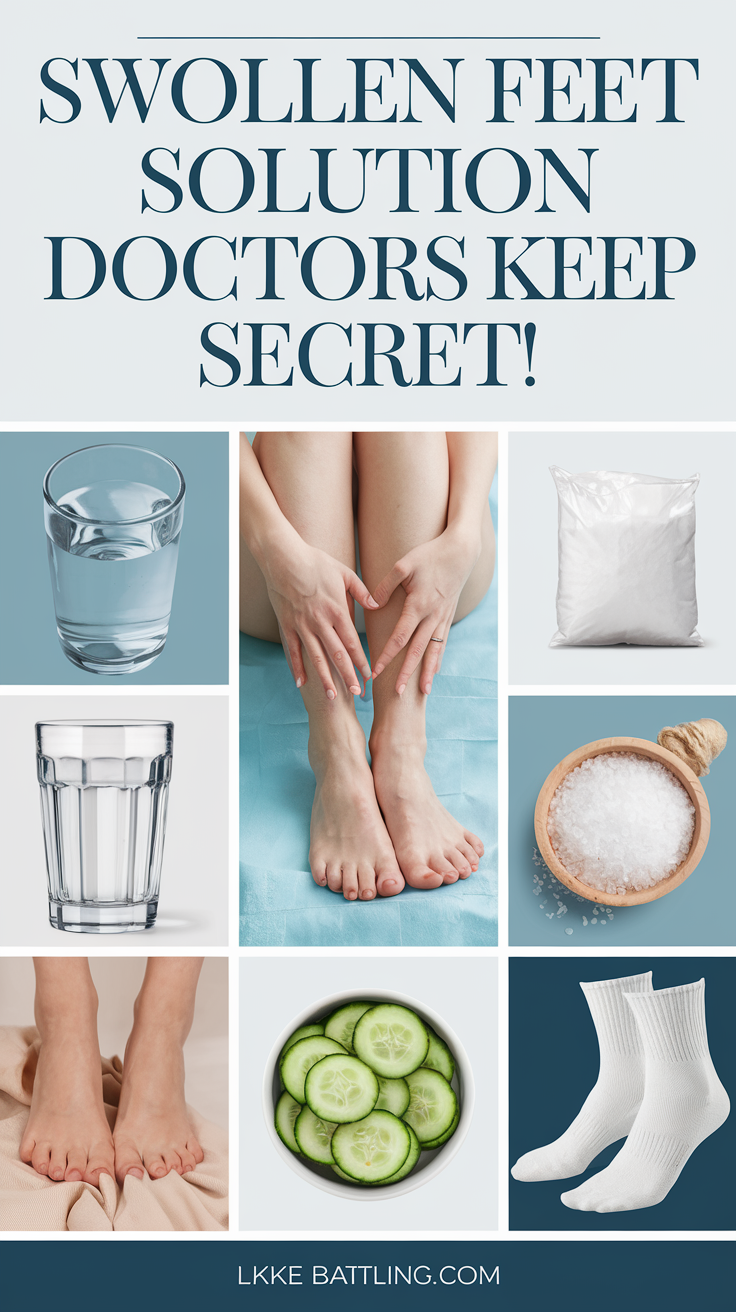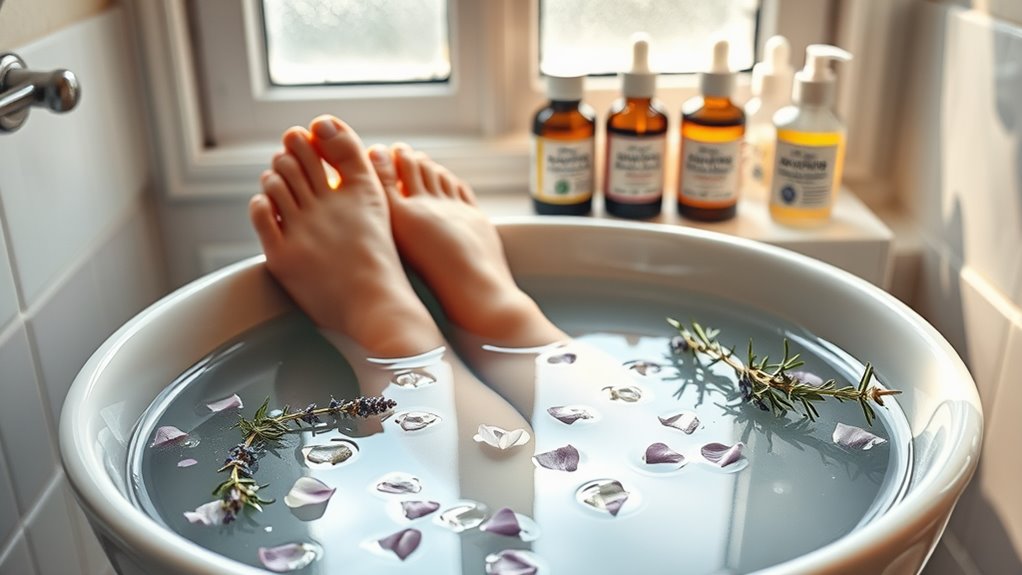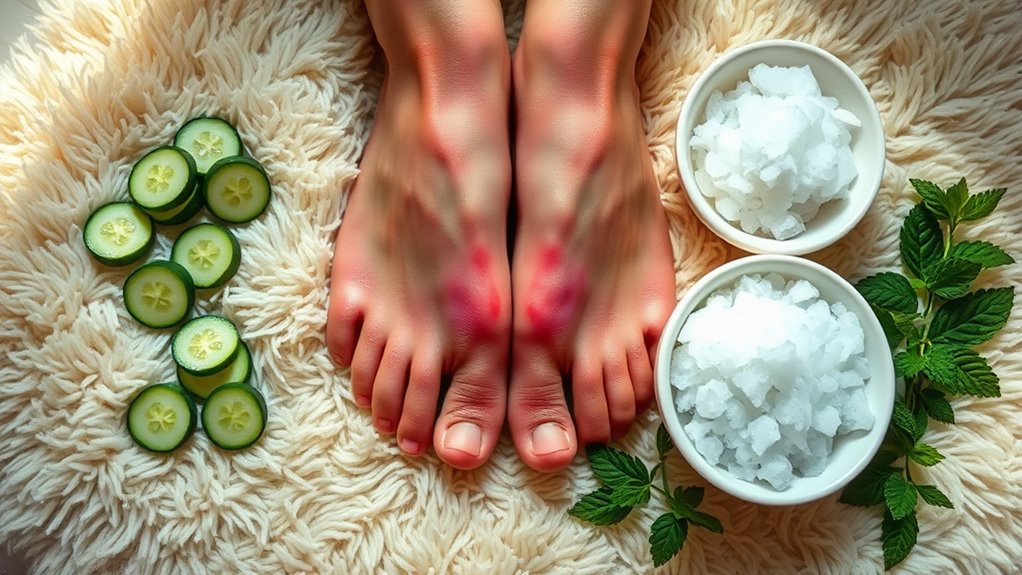Swollen Feet Solution Doctors Keep Secret!
You can naturally reduce foot swelling through strategic techniques that boost circulation. Elevate your feet above heart level for 15-20 minutes, three times daily, while doing gentle ankle rotations. Combine this with potassium-rich foods like bananas and leafy greens, plus compression socks during long periods of sitting or standing. For maximum relief, understanding the connection between mineral balance and fluid retention holds the key to lasting results.
Key Takeaways
-
Regular ankle rotations and foot exercises while sitting promote circulation and reduce swelling without medication or special equipment.
-
Elevating feet above heart level for 15-20 minutes, three times daily, naturally drains excess fluid from lower extremities.
-
Lymphatic drainage massage using gentle upward strokes from ankles to knees helps reduce swelling and improve circulation.
-
Consuming potassium-rich foods like bananas and leafy greens helps balance sodium levels and reduces fluid retention naturally.
-
Wearing compression socks during prolonged sitting or standing prevents fluid accumulation and maintains healthy circulation throughout the day.
Understanding the Root Causes of Foot Swelling
While many people experience swollen feet occasionally, understanding why this happens is essential for finding effective solutions. You’re not alone – this common condition affects millions, making it vital to identify its triggers.
Your feet might swell due to prolonged standing, pregnancy, or underlying health issues like poor circulation and heart problems.
Before trying swollen feet remedies, you’ll want to pinpoint what’s causing your discomfort. If you’re retaining fluid after long flights or hot weather, that’s different from swelling caused by medication side effects or kidney issues.
Some people notice their feet swell after eating salty foods or during certain times of their menstrual cycle. Understanding these patterns helps you choose the most appropriate treatment and know when to seek medical attention.
Hidden Medical Conditions Behind Swollen Feet
Although swollen feet might seem like a minor inconvenience, they can signal serious underlying medical conditions that require attention. Many of us don’t realize that swollen feet might indicate heart problems, kidney disease, or liver issues that you’ll want to address quickly with your healthcare provider.
You’re not alone if you’re experiencing foot swelling – it’s a common symptom of deep vein thrombosis, a dangerous blood clot condition that affects thousands each year.
Pregnancy complications, thyroid disorders, and lymphedema can also cause your feet to swell. Even certain medications you’re taking, like blood pressure pills or hormone treatments, might be the culprit behind your puffy feet.
Don’t ignore these signs – they’re your body’s way of telling you something isn’t right.
The Role of Circulation in Foot Swelling
Your body’s circulation system acts like a complex highway network, moving blood between your heart and feet. When this system isn’t working efficiently, you’ll notice your feet starting to swell as fluid builds up in your lower extremities.
You’re not alone if you’ve experienced this – many of us face circulation challenges, especially when we sit or stand for long periods. Your blood has to work against gravity to flow back up to your heart, and any interruption in this process can lead to swelling.
To keep your circulation flowing smoothly, you’ll want to move regularly throughout the day. Simple activities like ankle rotations, walking, or elevating your feet can make a significant difference.
Just like other members of our community, you’ll find these circulation-boosting habits become second nature with practice.
Essential Minerals That Combat Edema
When fluid retention causes swollen feet, certain minerals play an essential role in reducing edema naturally.
You’ll want to focus on potassium, which helps balance sodium levels and reduce water retention in your body. Many of us don’t get enough magnesium, another important mineral that regulates fluid balance and supports healthy circulation.
Don’t forget about calcium, which works together with magnesium to maintain proper fluid levels in your cells.
You can easily boost your mineral intake by adding bananas, leafy greens, nuts, and seeds to your daily diet.
If you’re dealing with persistent swelling, you might also consider taking a zinc supplement, as this mineral strengthens blood vessel walls and promotes better circulation throughout your feet and ankles.
Strategic Compression Techniques for Relief
Compression techniques offer targeted relief for swollen feet through strategic pressure application.
You’ll find that graduated compression socks and sleeves work by applying firm pressure at your ankles, gradually decreasing as they move up your leg. This helps push excess fluid back toward your heart.
To get the best results, slip on your compression gear first thing in the morning before swelling begins.
You’ll want to choose between knee-high socks for mild swelling or thigh-high options for more severe cases. Make sure they’re snug but not uncomfortably tight – you should be able to slide two fingers under the band.
Many athletes and professionals who spend long hours on their feet swear by this method, as it helps maintain proper circulation throughout the day.
Lesser-Known Herbal Remedies for Swelling
While traditional treatments remain popular, several lesser-known herbs have proven effective for reducing foot swelling.
You’ll find that dandelion root tea acts as a natural diuretic, helping your body release excess fluid. Horse chestnut extract, a trusted European remedy, can strengthen vein walls and improve circulation in your feet.
Another gem you mightn’t know about is butcher’s broom, which many people in our natural healing community use to reduce swelling and discomfort.
You can also try ginger root, either as a tea or supplement, to boost circulation and reduce inflammation.
For best results, pair these herbs with parsley or hibiscus tea – both excellent choices that others in the know have used successfully for generations to combat foot swelling.
Optimal Exercise Methods for Reducing Fluid Retention
Natural remedies work well alongside physical activity to combat swollen feet. You’ll find that simple movements can dramatically reduce fluid buildup and get you back to feeling like yourself again.
Start with ankle circles while seated, rotating each foot 10 times in both directions. Then try calf raises – stand on your tiptoes for 3 seconds, lower back down, and repeat 15 times.
Walking for just 15-20 minutes helps pump excess fluid back toward your heart. Swimming’s gentle resistance makes it perfect for reducing swelling without straining your joints.
If you’re at work, try pointing and flexing your toes under your desk every hour. For best results, combine these exercises with elevation breaks throughout your day, keeping your feet above heart level whenever possible.
Dietary Changes That Make a Difference
Making simple changes to your diet can substantially reduce foot swelling and improve circulation throughout your body.
Start by cutting back on sodium-rich foods, as excess salt leads to fluid retention. You’ll want to increase your potassium intake through bananas, sweet potatoes, and leafy greens to help balance sodium levels.
Stay hydrated by drinking plenty of water, which helps flush excess fluids from your system. Many people find that adding natural diuretics like cucumber, watermelon, and parsley to their meals makes a noticeable difference.
Don’t forget to incorporate magnesium-rich foods such as nuts, seeds, and whole grains – they’re excellent for reducing swelling. If you’re craving something sweet, opt for berries, which contain antioxidants that support healthy circulation and reduce inflammation.
Professional Treatment Options Rarely Discussed
Beyond lifestyle and dietary adjustments, several lesser-known professional treatments can tackle persistent foot swelling.
You’ll want to ask your doctor about specialized lymphatic drainage massage, a gentle technique that helps move trapped fluid back into circulation.
Another option you mightn’t know about is ultrasound therapy, which breaks down tissue congestion and improves blood flow.
Many aren’t aware that prescription compression stockings, custom-fitted by a professional, work far better than over-the-counter versions.
Your healthcare provider may also suggest targeted electrical stimulation therapy, which contracts muscles to pump excess fluid away.
Don’t overlook the benefits of medical acupuncture – it’s gaining recognition among doctors for reducing inflammation and improving circulation in ways that traditional treatments can’t match.
Advanced Massage Techniques for Lymphatic Drainage
To effectively reduce foot swelling at home, specific lymphatic drainage massage techniques can provide significant relief when done correctly.
Start by creating a gentle pumping motion above your ankles, working upward toward your knees. You’ll want to use light pressure – just enough to stretch the skin slightly.
Next, move your thumbs in small circular motions along the top of your foot, starting from your toes and working backward. This technique helps direct fluid toward your lymph nodes.
Don’t forget the often-overlooked areas between your toes, where fluid can accumulate.
Many of us notice the best results when performing these massages twice daily, especially before bed.
Remember to keep your movements gentle and rhythmic – you’re helping your body’s natural drainage system, not forcing the fluid out.
Alternative Therapies Worth Considering
While traditional treatments remain popular, several alternative therapies have shown promising results for swollen feet.
You’ll find that acupuncture can help improve circulation and reduce fluid retention, especially when combined with Chinese herbal medicine. Many of your fellow sufferers have experienced relief through reflexology, which targets specific pressure points in your feet.
You might also want to try hydrotherapy, where you’ll alternate between warm and cold water baths to stimulate blood flow.
Don’t overlook the benefits of yoga – specific poses like “legs up the wall” can naturally aid lymphatic drainage.
Essential oils like peppermint and cypress, when diluted and gently massaged into your feet, can provide soothing relief.
Join others who’ve discovered the effectiveness of these time-tested natural approaches.
Footwear Solutions Medical Experts Recommend
Medical experts consistently emphasize proper footwear as the foundation for managing swollen feet. You’ll want to choose shoes that support your feet while accommodating daily swelling patterns. Let’s look at expert-recommended footwear solutions that’ll help you stay comfortable and active.
| Shoe Feature | Expert Recommendation |
|---|---|
| Width | Adjustable straps or expandable sides |
| Material | Breathable mesh or soft leather |
| Sole | Shock-absorbing, non-slip rubber |
| Support | Built-in arch support and cushioning |
| Fit | Thumb-width space at toe box |
Your feet deserve shoes that flex with your daily needs. Remember to measure your feet in the evening when swelling typically peaks, and don’t hesitate to size up if needed. Many leading podiatrists suggest having multiple pairs to rotate throughout the day.
Warning Signs That Require Immediate Attention
Although most cases of swollen feet can be managed at home, certain warning signs demand immediate medical evaluation.
If you notice sudden, severe swelling in one leg, especially with warmth and redness, you might’ve a blood clot that requires urgent care. Don’t ignore these critical signs that many of us tend to overlook.
Rush to the emergency room if your swelling occurs with chest pain, shortness of breath, or fever, as these could indicate heart or kidney problems.
You’ll also want immediate attention if you have diabetes and develop swollen feet with signs of infection, like warmth or drainage.
Other red flags include skin that stays dimpled after you press it, or swelling that spreads up your leg.
We all want to stay safe, so it’s better to be cautious than sorry.
Preventive Measures for Long-Term Relief
Since long-term relief from swollen feet depends on daily habits, you’ll need to implement several preventive strategies into your routine.
Start by maintaining a healthy weight and staying active with low-impact exercises like swimming or walking. You’ll want to elevate your feet above heart level for 15-20 minutes, three times daily.
Join the many people who’ve discovered the benefits of compression socks during long periods of sitting or standing.
When you’re sleeping, prop your feet up on a pillow, and during the day, take regular breaks to stretch and move around.
You’ll also need to limit your salt intake and stay hydrated by drinking plenty of water.
Many successful people have found that these simple lifestyle changes make a significant difference in preventing swollen feet.
Sleep Positions That Reduce Morning Swelling
While you sleep, your body position dramatically affects how fluid accumulates in your feet overnight. Like many others dealing with morning swelling, you’ll find relief by elevating your feet above heart level using pillows or an adjustable bed.
The most effective position is lying on your back with your feet propped up at a 30-degree angle. You’re also welcome to try sleeping on your left side, which helps your body’s lymphatic system drain excess fluid more efficiently.
If you can’t sleep elevated all night, start with 20 minutes before bedtime. Many people in our community have found success by placing a firm pillow under their mattress at the foot of the bed, creating a gentle slope that works with gravity to prevent fluid buildup.
Impact of Temperature on Foot Swelling
Temperature plays a significant role in how your feet swell throughout the day. When you’re exposed to heat, your blood vessels dilate, causing increased blood flow to your feet and resulting in swelling. That’s why you’ll notice your shoes feeling tighter during hot summer days or after a warm bath.
Cold temperatures, on the other hand, can help reduce swelling by constricting blood vessels. You’re not alone if you’ve experienced relief after applying a cold compress or soaking your feet in cool water.
Many people find that alternating between warm and cold treatments helps manage swelling effectively. Just like others who deal with this common issue, you’ll get the best results by keeping your feet elevated while applying temperature therapy and avoiding prolonged exposure to extreme heat.
Occupational Factors and Management Strategies
Depending on your job, you may face different risks for foot swelling throughout the workday.
If you’re standing for long hours like nurses, retail workers, or teachers, you’ll need to take regular breaks and shift your weight between feet.
Office workers who sit all day aren’t off the hook either – prolonged sitting restricts blood flow to your feet.
To combat work-related swelling, try these proven strategies other professionals use: compression socks to promote circulation, supportive shoes with proper arch support, and periodic ankle rotations under your desk.
When possible, elevate your feet slightly while sitting, and take short walks every hour.
Many workers find success by keeping a small foot roller or massage ball at their workstation for quick relief during breaks.
Time-Tested Home Remedies With Scientific Backing
Although modern medicine offers various treatments for swollen feet, several traditional home remedies have stood the test of time and gained scientific support.
You’ll find relief by soaking your feet in Epsom salt baths, as magnesium sulfate reduces inflammation and draws out excess fluid. Elevating your feet above heart level for 15-20 minutes, three times daily, helps improve circulation and decrease swelling naturally.
Like many others who’ve found success with these methods, you can try compression socks, which research shows effectively reduce fluid buildup.
Additionally, you’ll benefit from gentle foot exercises – point and flex your toes, rotate your ankles, and roll your feet over a tennis ball. These movements stimulate blood flow and lymphatic drainage, helping your body naturally reduce swelling.
Frequently Asked Questions
Can Foot Swelling Indicate a Problem With My Internal Organs?
You’ll want to take swollen feet seriously – they can signal heart, kidney, or liver problems. When your organs aren’t working properly, fluid builds up and settles in your feet.
Why Do My Feet Swell More During Air Travel?
Your feet swell during flights because you’re sitting for long periods while cabin pressure changes. The lack of movement and gravity make it harder for blood to circulate properly.
Do Certain Medications Cause Foot Swelling as a Side Effect?
Yes, several medications you’re taking could cause your feet to swell, including blood pressure drugs, steroids, antidepressants, and hormones. You’ll want to discuss these side effects with your doctor.
Is Swelling in Only One Foot More Dangerous Than Both Feet?
You’ll want to take one-sided foot swelling seriously, as it could indicate a blood clot or injury. Both feet swelling is often less concerning, typically from general health issues.
Can Persistent Foot Swelling Affect My Bone Structure Over Time?
Yes, if you don’t treat chronic foot swelling, it can weaken your bones and joints, leading to changes in your foot structure and causing painful conditions like arthritis.








